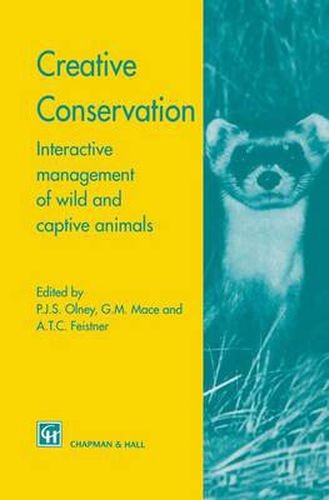Readings Newsletter
Become a Readings Member to make your shopping experience even easier.
Sign in or sign up for free!
You’re not far away from qualifying for FREE standard shipping within Australia
You’ve qualified for FREE standard shipping within Australia
The cart is loading…






This title is printed to order. This book may have been self-published. If so, we cannot guarantee the quality of the content. In the main most books will have gone through the editing process however some may not. We therefore suggest that you be aware of this before ordering this book. If in doubt check either the author or publisher’s details as we are unable to accept any returns unless they are faulty. Please contact us if you have any questions.
The question of the relationship between breeding endangered species in captivity and the conservation support needed in the field is crucial to the long term sucess of such programmes. How the captive breeding community relates to the wild, what is being done to help species and habitats survive and how to contribute in the future are all uppermost in the minds of those concerned to see successful outcomes to conservation efforts. This was addressed at the Sixth World Congress held in Jersey in 1992 on The Role of Zoos in Global Conservation . This book is the result of the deliberations of that important congress. However, it is more than just a conference proceedings. The editors and contributors have further developed the key issues tackled at that congress and the resulting chapters in this book represent an update on successes and developments to date. It will therefore be of vital interest to all those concerned with these issues. Presenting contributions from many of the leading experts from around the world, this book presents a full review of the biological, logistic and economic concerns that exist in all efforts to manage populations. Future objectives are also given and pertinent case studies illustrate the successes and frustrations encountered. It contributes to the debate about the interactive management of populations of animals that are under threat of extinction. This book should be of interest to conservation biologists, zoologists, aid agency personnel, environmental scientists, lay green people and those interested in zoo animal welfare.
$9.00 standard shipping within Australia
FREE standard shipping within Australia for orders over $100.00
Express & International shipping calculated at checkout
Stock availability can be subject to change without notice. We recommend calling the shop or contacting our online team to check availability of low stock items. Please see our Shopping Online page for more details.
This title is printed to order. This book may have been self-published. If so, we cannot guarantee the quality of the content. In the main most books will have gone through the editing process however some may not. We therefore suggest that you be aware of this before ordering this book. If in doubt check either the author or publisher’s details as we are unable to accept any returns unless they are faulty. Please contact us if you have any questions.
The question of the relationship between breeding endangered species in captivity and the conservation support needed in the field is crucial to the long term sucess of such programmes. How the captive breeding community relates to the wild, what is being done to help species and habitats survive and how to contribute in the future are all uppermost in the minds of those concerned to see successful outcomes to conservation efforts. This was addressed at the Sixth World Congress held in Jersey in 1992 on The Role of Zoos in Global Conservation . This book is the result of the deliberations of that important congress. However, it is more than just a conference proceedings. The editors and contributors have further developed the key issues tackled at that congress and the resulting chapters in this book represent an update on successes and developments to date. It will therefore be of vital interest to all those concerned with these issues. Presenting contributions from many of the leading experts from around the world, this book presents a full review of the biological, logistic and economic concerns that exist in all efforts to manage populations. Future objectives are also given and pertinent case studies illustrate the successes and frustrations encountered. It contributes to the debate about the interactive management of populations of animals that are under threat of extinction. This book should be of interest to conservation biologists, zoologists, aid agency personnel, environmental scientists, lay green people and those interested in zoo animal welfare.